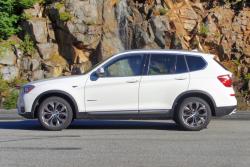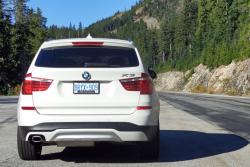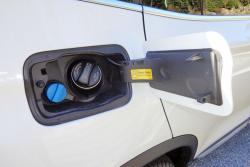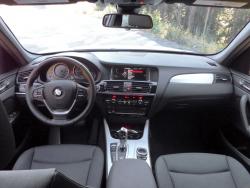The 2015 BMW X3 28d is the latest luxury SUV/crossover to offer a diesel engine as well as a choice of gasoline engines, joining the Audi Q5 TDI and Mercedes-Benz GLK 250 Bluetec in the compact luxury SUV segment. BMW’s combination of a small 2.0L turbocharged diesel mated to a standard eight-speed automatic transmission allows it to achieve the best fuel economy in the diesel SUV category: the X3 28d delivers 8.7 L/100 km in the city and 6.9 L/100 km on the highway, or a combined 7.8 L/100 km, according to the EPA. EPA figures for the Mercedes-Benz GLK250 Bluetec are 9.8 city/7.1 hwy/8.4 combined while the Audi Q5 TDI is 9.8 city/7.6 hwy/8.7 combined. In our week-long test drive, we recorded an average fuel economy reading of 8.1 L/100 km, not far off the EPA’s combined figure of 7.8 L/100 km and NRCan’s five-cycle average of 7.9 L/100 km. Notch one up for BMW.
However, the BMW’s fuel economy comes at the price of horsepower and torque output: while the X3 28d pumps out a modest 181 hp and a decent 280 lb-ft of torque, the Merc’s 2.1L turbo diesel develops 200 hp and 369 lb-ft of torque, while the Q5 TDI’s turbocharged 3.0L V6 diesel puts them both to shame with 240 hp and 428 lb-ft of torque.
But that doesn’t mean the X3 28d is a dog. It just means it has less power. And in a week of mixed city and highway driving, we had no complaints about the X3’s performance.
The reason is torque. Developing a maximum 280 lb-ft between 1,750 and 2,750 rpm, this little diesel engine with its common rail direct fuel injection, multi-stage turbocharging and variable turbine geometry, can vault the X3 from stop lights in a heartbeat and pull the X3 up steep hills with very little effort. True, the X3 28d’s (BMW supplied) 0 to 100 km/h time of 8.3 seconds isn’t awe-inspiring but it’s not slow either considering that this is a 1,919 kg five-passenger SUV with all-wheel drive. Admittedly, we didn’t try the X3 28d with a full load on board, but there seems to be plenty of extra power to compensate, particularly if the driver takes advantage of the performance-enhancing Sport mode.
Typical of modern diesels, you will notice some diesel clatter at idle, particularly if the windows are down, and under moderate to hard acceleration; but under steady-state driving and highway cruising, the diesel engine can barely be heard. And because it’s a diesel with an eight-speed automatic transmission that shifts often (and smoothly), the engine rarely has to rev above 2,000 rpm, thereby minimizing engine noise. Travelling on a level freeway at 100 km/h, the tachometer showed just 1,600 rpm in top gear.
The X3’s standard eight-speed automatic “Steptronic” transmission has a lot to do with the diesel X3’s excellent performance. It’s really a stellar cog changer, doing its job with no complaints or reservations. The driver can shift gears sequentially using the floor shifter after moving it to the M/S gate, but there are no shift paddles behind the steering wheel.
    2015 BMW X3 xDrive28d, fuel port, dashboard. Click image to enlarge |
As is the way these days, performance can be enhanced electronically by pressing the Sport button near the shift lever. This causes the engine to rev higher, the transmission to shift sooner, and the steering to quicken as well as deactivating the automatic stop/start system. But given that the performance in Normal mode is very good, we didn’t see the need to waste more diesel fuel in Sport Mode. Even in driver-selectable Eco Pro mode, the X3 28d accelerates and steers well while reducing fuel consumption by up to 20 percent, according to BMW. To save fuel, Eco Pro automatically selects the highest gear possible; in a gas engine, that usually saps performance, but in the X3’s low-revving 2.0L diesel engine, there’s plenty of torque even in higher gears.


















